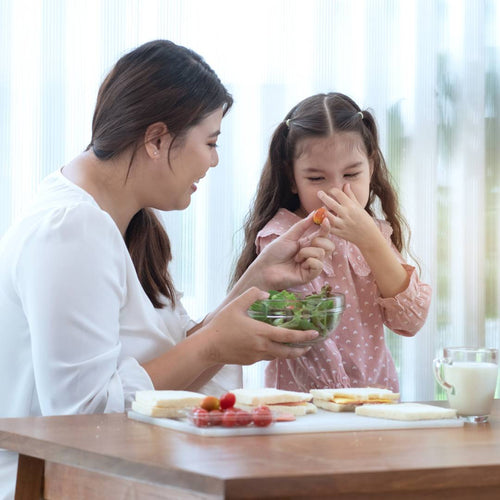Mealtimes can be an interesting time, especially if you’ve got a picky eater. It can so often end up as a battle of wills, with each side refusing to give in. It’s a common challenge, however, so despite the frustration and, often, wasted food, you’re most certainly not alone. And because it’s common, there is a whole range of strategies you can try out to help make mealtimes a tiny bit more peaceful and enjoyable. Today we’ll look through some of the different tips out there that others have tried out that can be a good starting off point for you in your journey.
Stay Calm
Yeah, sometimes this might seem a bit easier said than done, but remaining calm is one of the most important things to keep in mind. Avoid pressuring or forcing your child to eat. It’s incredibly common for a food to need to be offered up to 15 times before a child will accept it, but remaining calm and patient will help avoid your little one developing negative feelings around the food. Instead, try offering a variety of healthy options and let them decide how much to eat.
Make Mealtimes Fun & Engaging
Mealtimes can be fun, and it only takes a little effort! If you’ve got some cookie cutters, they can make what’s on the plate much more visually appealing, especially when it comes to sandwiches, fruit and vegetables. Likewise, what the food is served on can make a huge difference, as you probably know from your own adventures in buying dinnerware. Getting your child their own plate to eat off, especially if it’s in their favourite colour or with a design they particularly like, can make them much more open to eating from it. Likewise, their cutlery can make a difference, especially if they’re struggling a bit. Sets such as the Haakaa Silicone Kids Dinnerware Set could be a great option. The divided plate lets you separate out food, something many children find nicer to deal with, while each of the bendy cutlery parts lets them shape the fork and spoon to the way that’s comfortable for them, no matter which hand they use, making it much easier to ferry food to their mouths. There’s even an included bib with a pouch to catch food that drops as they’re eating, making cleanup much easier on you. Better still, each part is made with soft, high-quality food-grade silicone (and an iron rod in the centre of each fork and spoon), so it’s safe to have food on and gentle on their little mouths.
Another way to make things more fun is to have theme nights – think tacos, homemade pizzas, or pasta. Making these at home means you can not just make them healthy, but tailor them to be more appealing to your fussy eater. You can also try out getting them involved in the process. It’s incredible how many kids out there will happily eat something they’ve helped make, even if they didn’t want a bar of it the day before. Depending on their age, they might like to help out with tasks like washing vegetables, stirring, or setting the table – and you can build on that from there! This also has the added bonus of getting them used to the process of cooking from a young age, setting them up to develop the skills they’ll need later in life.
Repetition
This is a key point, and it goes back to what we mentioned earlier about it sometimes taking quite a few attempts before they’ll suddenly develop a liking for it, or even a willingness to try. Try adding a small amount of a new food alongside the foods they are eating, but don’t make a big deal about it. Keeping the quantities small can help them decide to try, since there isn’t a lot for them to have to get through.
Lead by Example
The most significant influence on your little one is you, so it can be great to model the behaviour you want them to engage in. The whole family coming together to eat the same range of healthy foods doesn’t just provide a template for them when it comes to building their own habits; it also lets them know that the food might actually be worth giving a go! At the same time, try to keep your discussions about food as positive as you can.
When to Seek Professional Advice
While most picky eating is a normal phase, there are times when it might be more concerning. If your child is consistently refusing entire food groups, experiencing weight loss or lack of growth, or showing extreme anxiety around food, it’s always a good idea to consult with your family doctor. They can help rule out any underlying medical conditions or provide more tailored strategies to help you both get through what can be a tough time.
It certainly can be difficult navigating mealtimes with picky eaters, but reaching out to others who have dealt with it for advice on what worked for them can be a real help, even if it’s just for the reminder that you’re not the only one. And don’t forget, if you’re worried, there is no harm in seeing your healthcare professional for either reassurance or investigation as necessary. Take a deep breath, and keep trying – you’ll all get there eventually!

